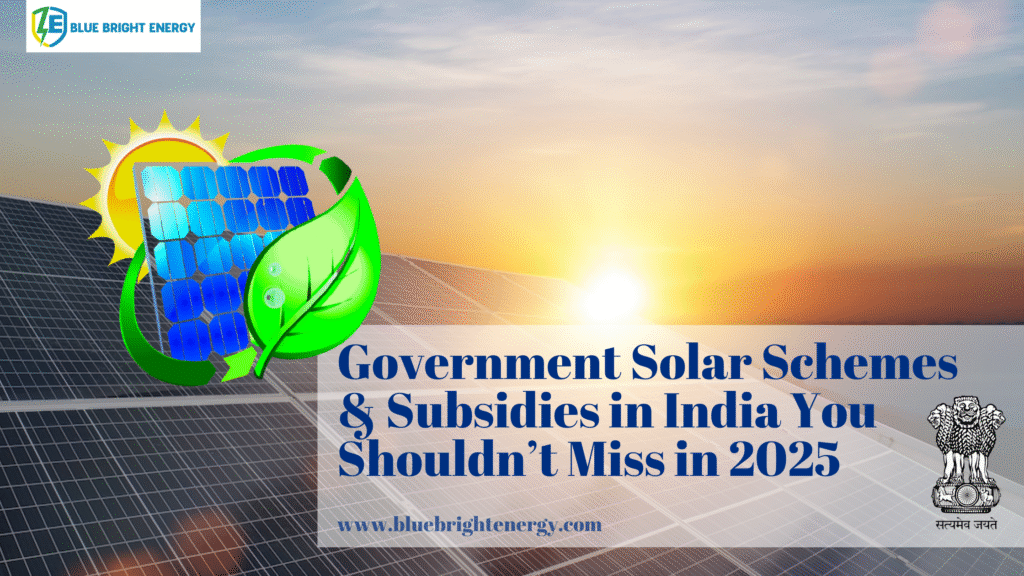Government Solar Schemes & Subsidies in India You Shouldn’t Miss in 2025

India’s solar revolution is reaching new heights in 2025. With the government launching several solar subsidy schemes and clean energy programs, there has never been a better time for households, farmers, and businesses to switch to solar power.
The government’s goal is clear to make renewable energy affordable, accessible, and beneficial for every Indian. From reducing electricity bills to supporting rural electrification, these schemes aim to create energy independence while helping India move closer to a greener future.
In this article, let’s explore the top solar government schemes and subsidies in India (2025) who can apply, how much subsidy you can get, and why now is the perfect time to go solar.
PM Surya Ghar Muft Bijli Yojana – Free Solar Electricity for Homes
The PM Surya Ghar Muft Bijli Yojana 2025 is one of India’s most ambitious rooftop solar initiatives, targeting 1 crore households. This program is designed to help families adopt on-grid rooftop solar systems without worrying about the high upfront cost.
Subsidy Details: Eligible households can receive up to ₹78,000 in solar subsidy, equivalent to around 300 units of free electricity per month.
Simplified Process: The government has introduced a faster, online application system that approves solar subsidy requests within 14 days, allowing households to track and manage their applications seamlessly.
Impact: States like Gujarat are already leading the way with over 3.36 lakh rooftop installations generating 1,232 MW of solar power — a clear sign of how simplified online solar processes are driving adoption.
PM-KUSUM Scheme – Solar Power for Farmers
The PM-KUSUM Scheme (Pradhan Mantri Kisan Urja Suraksha evam Utthaan Mahabhiyan) is transforming how India’s farmers use and produce energy. It focuses on solar water pumps and grid-connected solar power plants, helping farmers reduce irrigation costs and even earn by selling surplus power.
Subsidy Structure:
- 60% subsidy by the government
- 30% loan from banks
- 10% contribution by the farmer
This structure makes solar panel installation for farmers highly affordable while turning them into energy producers instead of just consumers. It’s not just about saving money — it’s about building energy self-reliant villages across India.
MNRE Rooftop Solar Programme – Power Your Roof, Power Your Home
The Grid-Connected Rooftop Solar Programme by the Ministry of New and Renewable Energy (MNRE) continues to encourage residential and institutional solar adoption.
Subsidy Rates 2025:
- 40% subsidy for solar systems up to 3 kW
- 20% subsidy for systems between 3 kW and 10 kW
This tiered structure allows families of all sizes to take advantage of solar subsidies in India, depending on their rooftop size and energy needs.
Net Metering & Export Incentives – Earn from Your Solar Power
Net metering is now standardized across India, allowing users to sell excess solar energy generated by their rooftop system back to the grid.
This means you don’t just save money — you earn credits or payments for the extra electricity your solar panels produce. For many homeowners, it’s like having a small side income every month while contributing to India’s renewable energy mission.
State-Specific Solar Subsidy Schemes 2025
Several states have also introduced additional incentives to make solar adoption more affordable:
- Delhi Solar Policy 2025: ₹10,000 per kW extra subsidy (up to ₹30,000 total).
- Haryana Solar Village Scheme: Focus on solarizing rural government buildings and Antyodaya families.
- Uttar Pradesh Solar Push: 22 GW solar target with new solar parks and storage systems.
- Bihar Kutir Jyoti Yojana: ₹60,000 crore project to provide free solar systems for 58.89 lakh BPL households.
These state-level solar programs make solar installation more accessible for every income group.
Why 2025 Is the Best Year to Go Solar in India
From residential rooftop solar panels to commercial solar installations and agricultural solar systems, 2025 offers the highest subsidies and fastest approval processes seen yet.
Government incentives, reduced installation costs, and improved solar technology mean that switching to solar power now can significantly lower your electricity bills while helping the planet.
Final Thoughts
The future of solar energy in India looks brighter than ever. Whether you’re a homeowner looking to save on monthly bills or a farmer aiming for energy independence, solar energy subsidies in 2025 can help you make the switch easily and affordably.
Ready for Solar Panel Installation in Madurai?
At Blue Bright Energy, we specialize in solar panel installation, solar subsidy consultation, and rooftop solar system solutions for homes, businesses, and farms in Madurai and nearby areas.
From helping you apply for solar subsidies in India 2025 to delivering end-to-end solar installation and maintenance, we make your transition to solar energy simple, transparent, and cost-effective.
Go solar today with Blue Bright Energy Your Trusted Solar Partner in Madurai!







